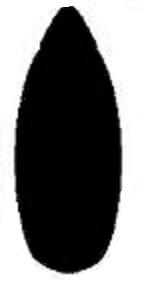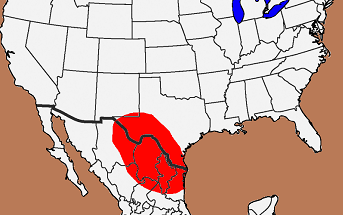Outline is Representative of Size and Shape:

Name Details:
Identified By: Kenneth Honea
Named For: Blanco River of Central Texas
Date Identified: 1965
Type Site:
Identified By: Kenneth Honea
Named For: Blanco River of Central Texas
Date Identified: 1965
Type Site:
Point Validity:
Provisional type
Honea was an anthropologist who conducted extensive studies in the Rio Grande Valley of New Mexico and Texas with Texas Tech University. He continued on to the University of Illinois and went on conduct studies in Romania. This type was named in a professional publication and has no to limited professional references. This is considered a provisional type.
Honea was an anthropologist who conducted extensive studies in the Rio Grande Valley of New Mexico and Texas with Texas Tech University. He continued on to the University of Illinois and went on conduct studies in Romania. This type was named in a professional publication and has no to limited professional references. This is considered a provisional type.
Blanco Ovoid
Provisional TypeCluster:
Description of Physical Characteristics and Flaking Pattern:
This is a thick ovoid shaped lanceolate point with a flattened elliptical cross section. The blade is excurvate with the broadest portion of the blade being just below the mid line. The base is convex. This point is manufactured using direct percussion flaking with pressure flaking along the edges being absent. Basal grinding is not known due the the weathering of the known points. The base is thinned using multi-directional flaking. This point has a random flaking pattern.
Size Measurements:
Total Length - 40 mm to 60 mm, Width - 20 mm to 25 mm, Thickness - 7 to 10 mm (based on small sample size)
Total Length - 40 mm to 60 mm, Width - 20 mm to 25 mm, Thickness - 7 to 10 mm (based on small sample size)
Commonly Utilized Material:
Additional Comments:
Honea (1965) notes that " Marie Wormington, has suggested that points much like those of our Blanco type may well have been the basic type from which later Early Man points evolved."
Honea (1965) notes that " Marie Wormington, has suggested that points much like those of our Blanco type may well have been the basic type from which later Early Man points evolved."
Distribution:

Distribution Comments:
This point is primarily found along the Blanco River of Central Texas and has been reported in other parts of Texas and also in central and southeast New Mexico, Chihuahua, Coahuila, Nuevo Leon, and Tamaulipas.
This point is primarily found along the Blanco River of Central Texas and has been reported in other parts of Texas and also in central and southeast New Mexico, Chihuahua, Coahuila, Nuevo Leon, and Tamaulipas.
Age / Periods:
Date:
Cultural Period: Late Paleo
Glacial Period: Late Pleistocene
Culture: San Marcos Complex
Date:
Cultural Period: Late Paleo
Glacial Period: Late Pleistocene
Culture: San Marcos Complex
Age Details:
Other points in this cluster / Related / Associated Points:

